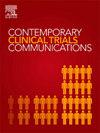Detection of Undiagnosed Liver Cirrhosis via Artificial Intelligence-Enabled Electrocardiogram (DULCE): Rationale and design of a pragmatic cluster randomized clinical trial
IF 1.4
Q4 MEDICINE, RESEARCH & EXPERIMENTAL
引用次数: 0
Abstract
Background
Cirrhosis is a leading cause of morbidity and mortality worldwide, yet preventable at early stages. Currently, effective approaches for early diagnosis are lacking. A novel electrocardiogram (ECG)-enabled deep learning model trained for detection of advanced chronic liver disease (CLD) has demonstrated promising results and it may be used for screening of advanced CLD in primary care.
Design
A pragmatic, cluster randomized trial (NCT05782283) in 45 Mayo Clinic primary care practices will be conducted over a period of 6 months with 6 months of follow up. Care teams will be randomized 1:1 to intervention or usual care, stratified by region and patient volume. Patients from providers enrolled in the trial who undergo an ECG during the study period will be included. In the intervention arm, consenting providers to patients identified as higher risk of advanced CLD based on their ECG will be notified with a recommendation for noninvasive fibrosis assessment. The primary endpoint will be detection of advanced CLD (defined as stage 3–4 on blood- or imaging-based noninvasive liver disease assessment or liver biopsy). Secondary outcomes will include completion of fibrosis assessment tests within 180 days of ECG, new diagnosis of liver disease stratified by etiology and risk factors for CLD, and detection of any liver fibrosis (stages 1–4). Post-study surveys to participating clinicians will be conducted.
Summary
Preliminary findings suggest outstanding potential for the use of an ECG-enabled machine learning algorithm for detection of advanced CLD in the primary care community.
通过人工智能心电图(DULCE)检测未确诊的肝硬化:一项实用的随机临床试验的基本原理和设计
肝硬化是世界范围内发病率和死亡率的主要原因,但在早期阶段是可以预防的。目前,缺乏有效的早期诊断方法。一种用于检测晚期慢性肝病(CLD)的新型心电图(ECG)支持深度学习模型已经显示出有希望的结果,它可以用于初级保健中晚期慢性肝病的筛查。设计一项实用的集群随机试验(NCT05782283)将在45个梅奥诊所初级保健实践中进行为期6个月的随访。护理小组将按地区和患者数量按1:1随机分为干预组或常规护理组。在研究期间接受心电图检查的患者将被纳入试验。在干预组,根据患者的心电图,同意的提供者被确定为晚期CLD风险较高的患者,将被告知建议进行无创纤维化评估。主要终点将是检测晚期CLD(定义为血液或基于影像学的无创肝病评估或肝活检的3-4期)。次要结局将包括心电图180天内完成纤维化评估试验,根据病因和CLD危险因素分层的肝脏疾病的新诊断,以及任何肝纤维化的检测(1-4期)。将对参与的临床医生进行研究后调查。初步研究结果表明,在初级保健社区中,使用心电图支持的机器学习算法来检测晚期CLD具有巨大的潜力。
本文章由计算机程序翻译,如有差异,请以英文原文为准。
求助全文
约1分钟内获得全文
求助全文
来源期刊

Contemporary Clinical Trials Communications
Pharmacology, Toxicology and Pharmaceutics-Pharmacology
CiteScore
2.70
自引率
6.70%
发文量
146
审稿时长
20 weeks
期刊介绍:
Contemporary Clinical Trials Communications is an international peer reviewed open access journal that publishes articles pertaining to all aspects of clinical trials, including, but not limited to, design, conduct, analysis, regulation and ethics. Manuscripts submitted should appeal to a readership drawn from a wide range of disciplines including medicine, life science, pharmaceutical science, biostatistics, epidemiology, computer science, management science, behavioral science, and bioethics. Contemporary Clinical Trials Communications is unique in that it is outside the confines of disease specifications, and it strives to increase the transparency of medical research and reduce publication bias by publishing scientifically valid original research findings irrespective of their perceived importance, significance or impact. Both randomized and non-randomized trials are within the scope of the Journal. Some common topics include trial design rationale and methods, operational methodologies and challenges, and positive and negative trial results. In addition to original research, the Journal also welcomes other types of communications including, but are not limited to, methodology reviews, perspectives and discussions. Through timely dissemination of advances in clinical trials, the goal of Contemporary Clinical Trials Communications is to serve as a platform to enhance the communication and collaboration within the global clinical trials community that ultimately advances this field of research for the benefit of patients.
 求助内容:
求助内容: 应助结果提醒方式:
应助结果提醒方式:


